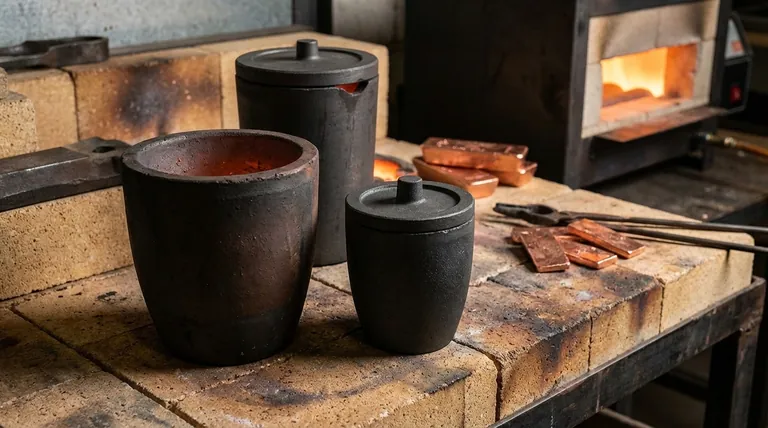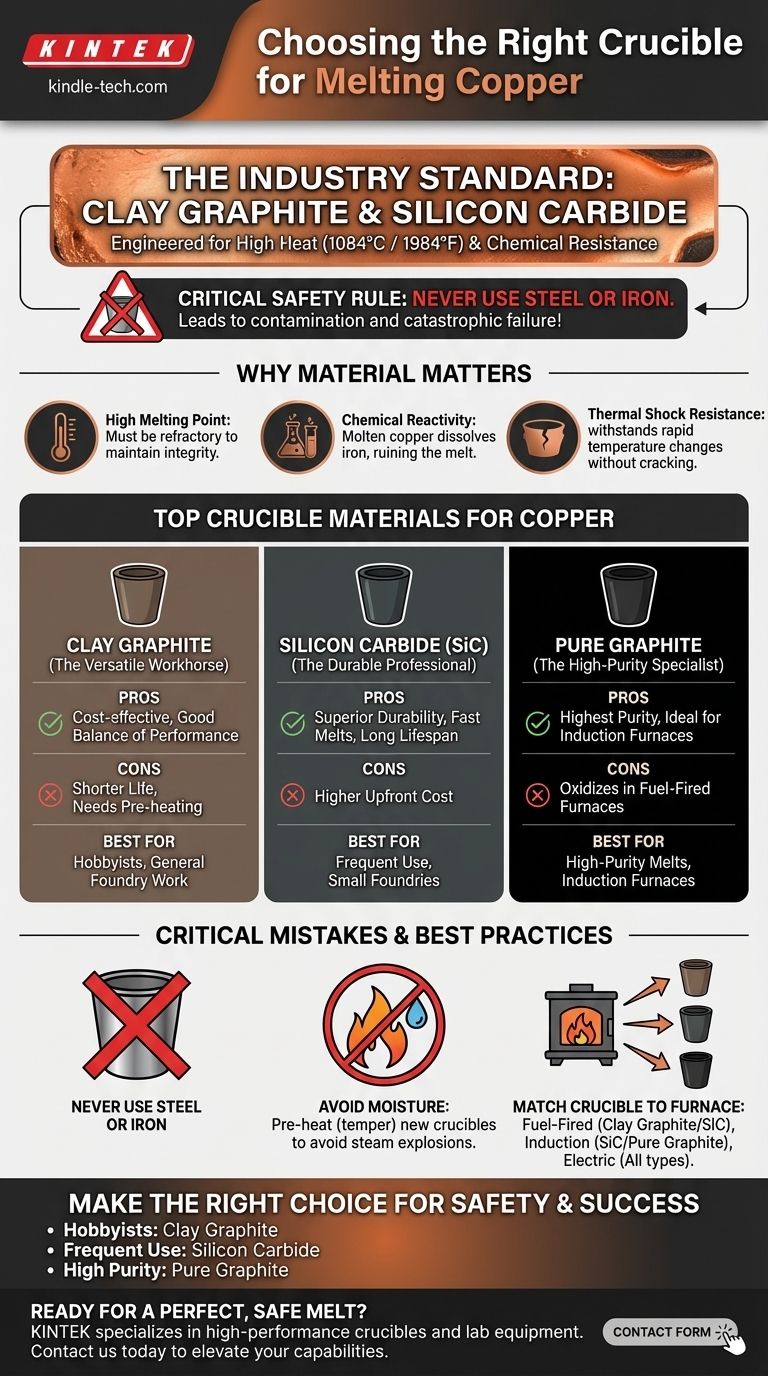For melting copper, the industry-standard and most recommended crucible materials are clay graphite and silicon carbide. These materials are engineered to withstand copper's high melting point (1084°C / 1984°F) while also resisting chemical reactions with the molten metal. Their excellent thermal conductivity ensures an even and efficient melt, making them the safest and most reliable choices for both hobbyists and professionals.
Choosing a crucible for copper is not just about heat tolerance; it's about chemical compatibility. Using the wrong material, like steel, will lead to rapid crucible failure and a contaminated melt. The right material, however, is the foundation for a safe, efficient, and successful casting process.

Why Material Choice is Critical for Copper
Understanding the "why" behind material selection is crucial for safety and quality. Copper presents a unique set of challenges that dictate which crucibles are suitable and which are dangerously inappropriate.
Copper's High Melting Point
Copper melts at a temperature that is far beyond the limits of many common materials. A proper crucible must be refractory, meaning it can maintain its structural integrity at extremely high temperatures without melting, warping, or breaking down.
The Problem of Chemical Reactivity
Molten copper is an aggressive solvent for certain metals, most notably iron. If you attempt to melt copper in a steel or iron container, the molten copper will begin to dissolve the crucible itself. This process ruins both the crucible and the melt, creating a weak, brittle iron-copper alloy and risking a catastrophic failure and spill.
The Need for Thermal Shock Resistance
A crucible undergoes immense stress as it's heated from room temperature to over 1000°C and then cooled again. Materials with poor thermal shock resistance will crack under this rapid temperature change. Graphite is exceptional in this regard, which is why it's a key component in the best crucibles.
Comparing the Top Crucible Materials for Copper
There are three primary materials used for copper melting, each with distinct advantages and use cases.
Clay Graphite: The Versatile Workhorse
Clay graphite crucibles are a composite made from flake graphite, silicon carbide, and clay binders. They are the most common choice for general foundry work.
Pros: They offer a great balance of thermal conductivity and durability at an affordable price. They are the default, reliable choice for hobbyists and many small foundries.
Cons: They have a shorter service life compared to silicon carbide and can be more susceptible to damage from rough handling.
Silicon Carbide (SiC): The Durable Professional
Silicon carbide crucibles are a higher-performance option, often distinguished by their uniform dark grey or black appearance. They are composed of graphite and a high percentage of silicon carbide.
Pros: They have superior thermal conductivity (leading to faster melts and lower fuel costs), exceptional strength, and a significantly longer lifespan than clay graphite.
Cons: Their primary drawback is a higher upfront cost, though this is often offset by their longevity in high-volume settings.
Pure Graphite: The High-Purity Specialist
These crucibles are machined from solid blocks of high-density graphite. They offer the highest purity and thermal performance.
Pros: They are ideal for applications requiring zero contamination, such as in laboratories or for casting precious metals. They are the preferred choice for induction furnaces, which heat the crucible material directly.
Cons: Graphite oxidizes (essentially burns away) in the presence of oxygen at high temperatures. In a typical fuel-fired furnace, a pure graphite crucible will have a much shorter life than a composite one.
Understanding the Trade-offs & Critical Mistakes
Choosing a material is only part of the equation. Understanding how to use it safely and what to avoid is paramount.
The Critical Mistake: Never Use a Steel or Iron Crucible
This cannot be overstated. Placing copper in a steel or iron container at melting temperatures is a recipe for failure. The copper will dissolve the iron, destroying the container and contaminating your metal. This can lead to a sudden and extremely dangerous spill of molten metal.
The Hidden Risk: Moisture in Your Crucible
Clay graphite crucibles are slightly porous and can absorb moisture from the air, especially if stored in a damp environment. Heating a damp crucible too quickly will cause this trapped moisture to turn into steam, which can crack or even shatter the crucible.
Always pre-heat (temper) a new or long-stored crucible by heating it slowly and gently to a few hundred degrees to drive off any moisture before charging it with metal.
Matching Your Crucible to Your Furnace
The type of furnace you use can influence the ideal crucible choice.
- Fuel-Fired (Propane, Gas): Clay graphite and silicon carbide are excellent choices. Pure graphite will wear out very quickly due to oxidation from the flame.
- Induction Furnace: Silicon carbide and pure graphite are ideal. The furnace's electromagnetic field heats the conductive crucible material directly and efficiently.
- Electric Resistance Furnace: All three types work well, as the controlled environment minimizes the harsh oxidation seen in fuel-fired furnaces.
Making the Right Choice for Your Project
Your ideal crucible depends on your budget, frequency of use, and specific goals.
- If you are a hobbyist or just starting out: Choose a clay graphite crucible for its excellent balance of performance and cost.
- If you run a small foundry or melt copper frequently: Invest in a silicon carbide (SiC) crucible for its longer lifespan and greater efficiency, which will save you money over time.
- If your primary focus is achieving the highest purity melt: Use a pure graphite crucible, preferably within an induction or electric furnace to minimize oxidation.
- If you are ever tempted to use a repurposed steel container: Do not. The risk of catastrophic failure and a dangerous molten metal spill is too high. Always purchase a properly rated refractory crucible.
Selecting the correct crucible is the foundational step for a safe and successful copper melting operation.
Summary Table:
| Crucible Material | Best For | Key Advantage | Key Consideration |
|---|---|---|---|
| Clay Graphite | Hobbyists, General Foundry Work | Excellent balance of cost & performance | Shorter lifespan, requires pre-heating |
| Silicon Carbide (SiC) | Frequent Use, Small Foundries | Superior durability & thermal efficiency | Higher upfront cost |
| Pure Graphite | High-Purity Melts, Induction Furnaces | Highest purity & thermal performance | Oxidizes in fuel-fired furnaces |
Ready to achieve a perfect, safe melt?
Choosing the right crucible is the first step to a successful casting project. KINTEK specializes in high-performance lab equipment and consumables, including a full range of crucibles designed for materials like copper. Our experts can help you select the ideal crucible for your specific furnace and application, ensuring efficiency, safety, and superior results.
Contact us today to find your perfect crucible solution and elevate your lab's capabilities.
Visual Guide

Related Products
- High Purity Pure Graphite Crucible for Electron Beam Evaporation
- Electron Beam Evaporation Coating Oxygen-Free Copper Crucible and Evaporation Boat
- High Purity Pure Graphite Crucible for Evaporation
- Custom Machined and Molded PTFE Teflon Parts Manufacturer with PTFE Crucible and Lid
- Engineering Advanced Fine Ceramics Alumina Al2O3 Crucible With Lid Cylindrical Laboratory Crucible
People Also Ask
- How does a magnetron sputtering work? A Guide to High-Quality Thin Film Deposition
- What is sputtering in plasma treatment? A Guide to High-Purity Thin Film Deposition
- What are the effects of magnetron sputtering? Achieve High-Quality, Durable Thin Films for Your Lab
- What is the difference between VAR and ESR? A Guide to Understanding Tail Risk in Financial Modeling
- What are the disadvantages of DC magnetron sputtering? Key Limitations for Your Lab



















